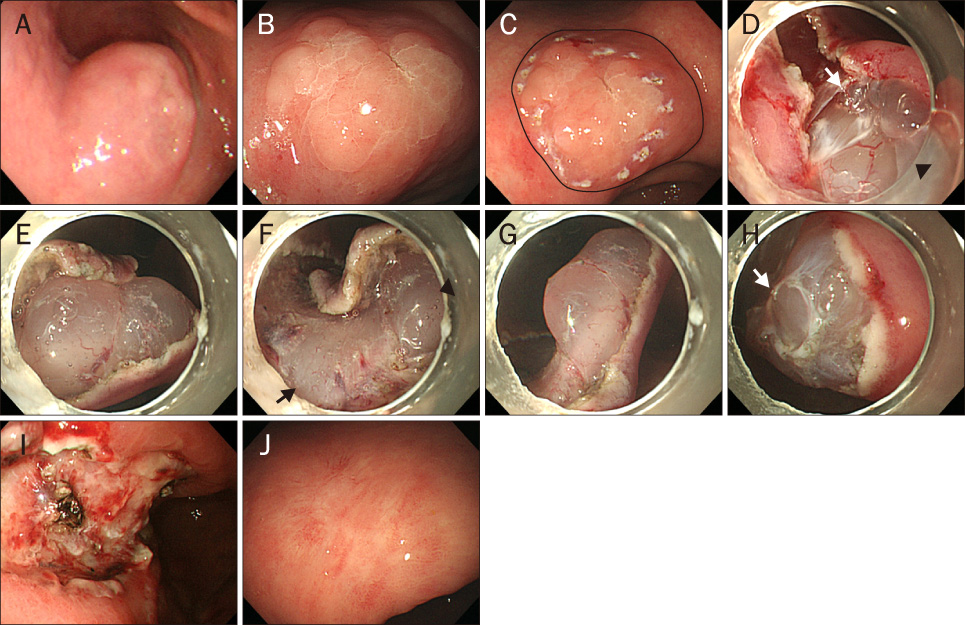Korean J Gastroenterol.
2012 May;59(5):366-371. 10.4166/kjg.2012.59.5.366.
A Ten-year Follow-up of a Case with Gastric Adenoma Accompanied with Gastritis Cystica Profunda Treated by Endoscopic Submucosal Dissection
- Affiliations
-
- 1Department of Internal Medicine, Bundang Jesaeng General Hospital, Seongnam, Korea. parkjs@dmc.or.kr
- 2Department of Pathology, Bundang Jesaeng General Hospital, Seongnam, Korea.
- KMID: 1792836
- DOI: http://doi.org/10.4166/kjg.2012.59.5.366
Abstract
- Gastritis cystica profunda (GCP) is an uncommon hyperplastic benign lesion, and histologically characterized by hyperplasia and cystic dilatation of the gastric glands extending into the submucosal layer. GCP usually occurs at a gastroenterostomy site, although it can occasionally be found in an unoperated stomach. GCP is thought to be a possible precancerous lesion, since a few early gastric cancers associated with it were reported. Herein, we report a case of gastric adenoma associated with GCP in an unoperated patient. The sizes of both the GCP and adenoma overlying it have increased during a 10 year follow-up period. Adenoma on the latest biopsy showed low grade dysplasia, and it was successfully treated by endoscopic submucosal dissection.
MeSH Terms
Figure
Reference
-
1. Littler ER, Gleibermann E. Gastritis cystica polyposa. (Gastric mucosal prolapse at gastroenterostomy site, with cystic and infiltrative epithelial hyperplasia). Cancer. 1972. 29:205–209.2. Franzin G, Novelli P. Gastritis cystica profunda. Histopathology. 1981. 5:535–547.3. Kim W, Park SC, Lee JY, et al. A case of gastric adenocarcinoma diagnosed after being followed up as submucosal tumor for 10 years. Korean J Gastroenterol. 2001. 37:291–295.4. Iwanaga T, Koyama H, Takahashi Y, Taniguchi H, Wada A. Diffuse submucosal cysts and carcinoma of the stomach. Cancer. 1975. 36:606–614.5. Chakrovorty RC, Schatzki PF. Gastric cystic polyposis. Am J Dig Dis. 1975. 20:981–989.6. Cho HJ, Kim JE, Jeong BJ, et al. A case of gastric adenocarcinoma arising from gastritis cystica profunda. Korean J Gastrointest Endosc. 2004. 28:237–241.7. Chung IK, Kim EJ, Kim DJ, et al. Clinical significance of endoscopic Ultrasonography in gastritis cystica polyposa. Korean J Gastrointest Endosc. 2001. 22:195–210.8. Moon SY, Kim KO, Park SH, et al. Gastritis cystica profunda accompanied by multiple early gastric cancers. Korean J Gastroenterol. 2010. 55:325–330.9. Aoyagi K, Koufuji K, Yano S, et al. Two cases of cancer in the remnant stomach derived from gastritis cystica polyposa. Kurume Med J. 2000. 47:243–248.10. Song YL, Park JY, Kim YB, et al. A case of gastritis cystica profunda associated with high grade tubular adenoma. Korean J Gastroenterol. 2004. 43:52–55.11. Park CH, Park JM, Jung CK, et al. Early gastric cancer associated with gastritis cystica polyposa in the unoperated stomach treated by endoscopic submucosal dissection. Gastrointest Endosc. 2009. 69:e47–e50.
- Full Text Links
- Actions
-
Cited
- CITED
-
- Close
- Share
- Similar articles
-
- A Case of Gastritis Cystica Profunda Showing Giant Gastric Mucosal Fold
- A Case of Gastritis Cystica Profunda Presenting with a Submucosal Cystic Tumor
- A Case of Gastric Inverted Hyperplastic Polyp Found with Gastritis Cystica Profunda and Early Gastric Cancer
- A Case of Gastritis Cystica Profunda Associated with High Grade Tubular Adenoma
- Gastritis Cystica Profunda: A case report




